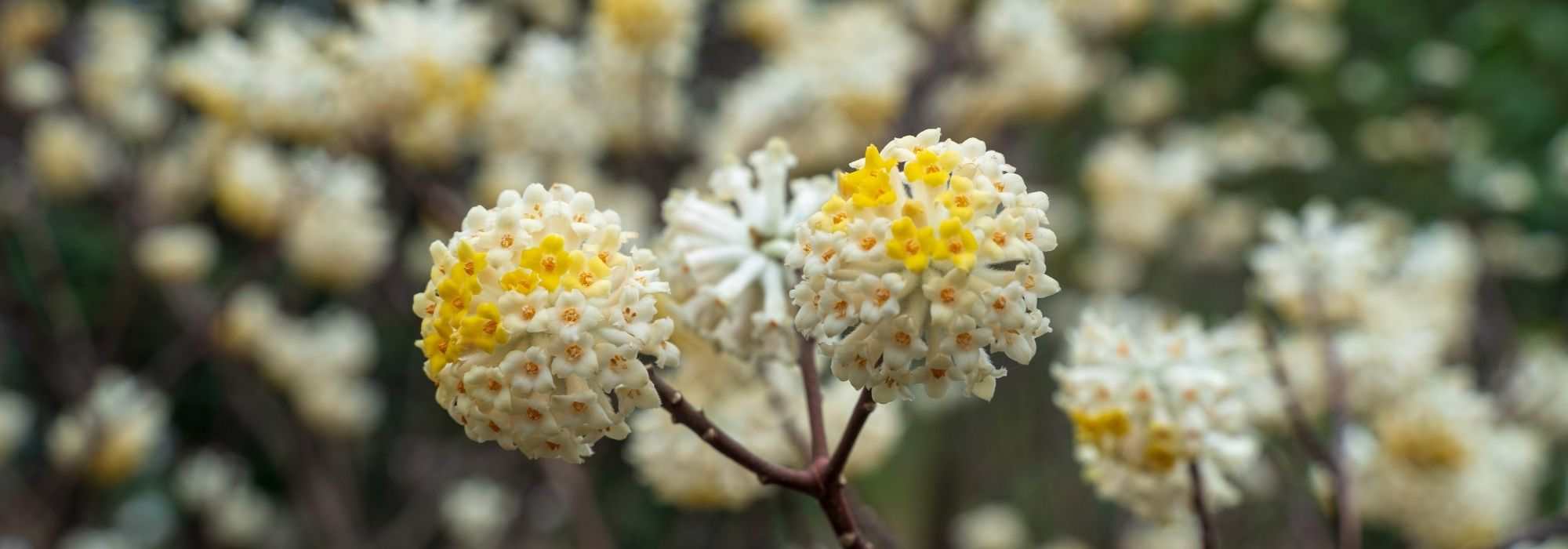
6 pairing ideas with Edgeworthia
To create a unique atmosphere in your garden
Contents
Original and still relatively unknown, Edgeworthia is a shrub for collection with very interesting decorative qualities. Nicknamed the “Paper Bush,” it is native to China, and its wood is used to make luxury paper. It flowers at the end of winter, from February to April, adorned with small clusters of tubular flowers at a time when the garden appears bare. Yellow, white, orange, or red and fragrant, the flowers appear before the leaves, creating a contrast with the naked wood. Moderately hardy, Edgeworthia thrives in open ground in regions with a mild and oceanic climate, such as Brittany or areas south of the Loire. It can also be grown in pots where temperatures drop below -10°C. Discover our ideas for pairing this original shrub and highlighting its warm-toned winter flowering.
In a pot on a terrace or in a garden
Slow-growing and moderately hardy, Edgeworthia thrives well in pots. This allows it to be brought indoors for protection during winter if necessary, while enjoying the changing spectacle it offers throughout the seasons. Edgeworthia has a unique silhouette, reaching heights between 1 metre and 2 metres, with a short trunk, regular branching, and reddish-brown bark. Each branch divides into three secondary shoots. On the naked branches, clusters of 30 to 50 tubular, fluffy flowers appear in late winter, from February to March, and even into April for some varieties. Its flowers brighten the garden or terrace with warm, vibrant colours: yellow and white for Edgeworthia chrysantha, Edgeworthia chrysantha grandiflora, and Edgeworthia chrysantha ‘Nanjing Gold’, and orange to red for Edgeworthia chrysantha ‘Red Dragon’ Akebono. After flowering, the bush is adorned with inedible fruit resembling drupes, as well as large lanceolate leaves measuring 15 to 20 cm, creating a lush and exotic atmosphere from spring to autumn.
The intense fragrance of its flowers, with notes of honeysuckle, jasmine, or clove, is another of its assets. To fully enjoy its scents, place it on your terrace, near a window, entrance, or pathway. For a floral winter ambiance, position it next to another winter-flowering bush also grown in a pot, such as a daphne odora ‘Aureomarginata’ with evergreen, variegated yellow and green foliage, which produces small, highly fragrant light pink flower clusters in February and March. You can also place it next to a winter-flowering camellia, such as the camellia ‘Jurys Yellow’ in white and cream, or the camellia ‘Marshmallow’ with red flowers and a white centre.
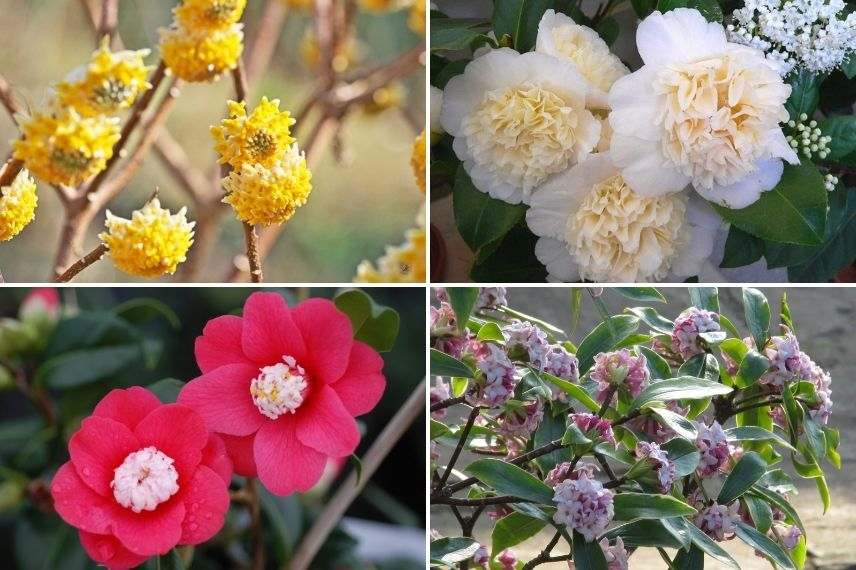
Edgeworthia chrysantha, Camellia ‘Jury’s Yellow’ (photo Wikipedia), Camellia ‘Marshmallow’ and Daphne odora ‘Aureomarginata’ (photo Peganum)
In a bed of ericaceous plants
In regions south of the Loire or in mild, humid oceanic climates, Edgeworthia can be grown in the ground. It prefers acidic, cool, fertile, and well-drained soils. This makes it the ideal bush to plant in a bed of ericaceous plants in these areas. Pair it with camellias, rhododendrons and azaleas, daphnes, and kalmias to create a refined flower bed. At its base, you can plant heathers in pink, white, or violet. The white, yellow, and orange hues of Edgeworthia allow for the creation of warm-toned harmonies.
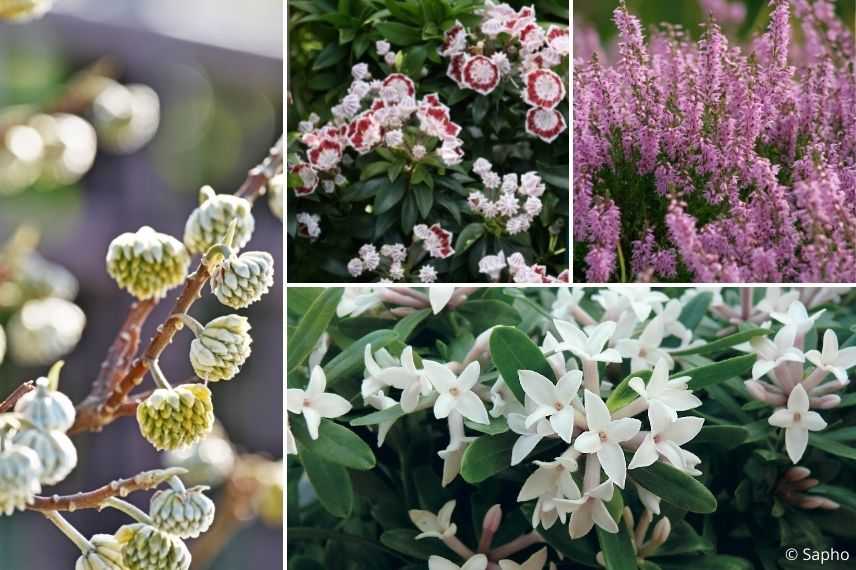
Edgeworthia chrysantha, Kalmia latifolia ‘Minuet’, Calluna vulgaris H.E Beale’ and Daphne ‘Eternal Fragrance’
Discover other Edgeworthia
View all →Available in 0 sizes
Available in 1 sizes
Available in 1 sizes
Available in 1 sizes
Available in 1 sizes
Available in 1 sizes
In a flowerbed that blooms all year round
With its late winter flowering, Edgeworthia can be paired with other plants that bloom between spring and autumn, to create a flowering bed throughout the seasons. Plant for example at the base of the Edgeworthia chrysantha which produces bicoloured white and yellow flowers, spring bulbs in similar tones such as daffodils or jonquils. For added flair, you can combine it with blue bulbs like hyacinths or muscari. Another very graphic idea is to plant fritillaries that come in various colours, such as Fritillaria imperalis ‘Rubra’, spectacular with its crowns of large orange bells, which appear between April and May.
To extend the pleasure of flowering into summer and then autumn, you will have plenty of choices. Find for example your inspiration in summer bulbs, such as white or purple agapanthus, begonias with a wide colour palette, as well as in autumn-flowering bulbs like Naples cyclamen or colchicum. Add hellebores to enjoy a flowering that lasts until winter. To enhance the graphic aspect of your bed, consider euphorbias, which structure a bed with their finely cut, evergreen foliage.

Edgeworthia chrysantha, Euphorbia characias wulfenii, Agapanthus ‘Navy Blue’, Cyclamen hederifolium and Narcissus ‘Spring Sunshine’
In a colourful border in winter
Edgeworthia can be used to create a very decorative winter border when combined with other winter-flowering bushes like itself, as well as with shrubs that have decorative bark. You can plant it next to, for example, an hamamelis with orange tones, a Japanese quince in orange or white, or even a forsythia in yellow. Add to the border one or more dogwoods that will showcase their originality in winter with their astonishingly coloured red or yellow bark. Plant at the base of the shrubs different varieties of hellebores: single or double, light or dark. To further enhance originality, install in your border Garrya elliptica, which offers long, pendulous white aments that are very decorative in the heart of winter.
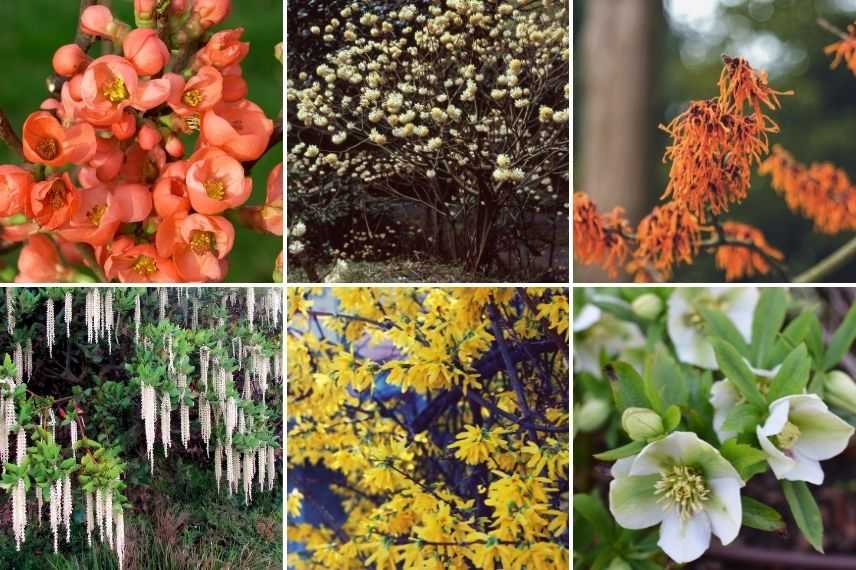
Chaenomeles speciosa ‘Friesdorfer’, Edgeworthia chrysantha (photo Nishimoto), Hamamelis intermedia ‘Aphrodite’, Garrya elliptica (photo hortulus), Forsythia and Hellebore
To create an Asian atmosphere
Native to China, Edgeworthia has a lovely habit and can be planted in a garden with an Asian or Japanese feel. In this type of garden, you can pair it for example with the delicacy of a Japanese maple, whose leaves turn red in autumn, set against a lush background of bamboo. Also consider planting nearby a Stachyurus chinensis which offers a stunning winter flowering of clusters of pendulous yellow or white bells. You can also choose a Japanese andromeda, a very decorative Asian bush with evergreen foliage that produces a flowering between February and June, with white bells grouped in clusters.
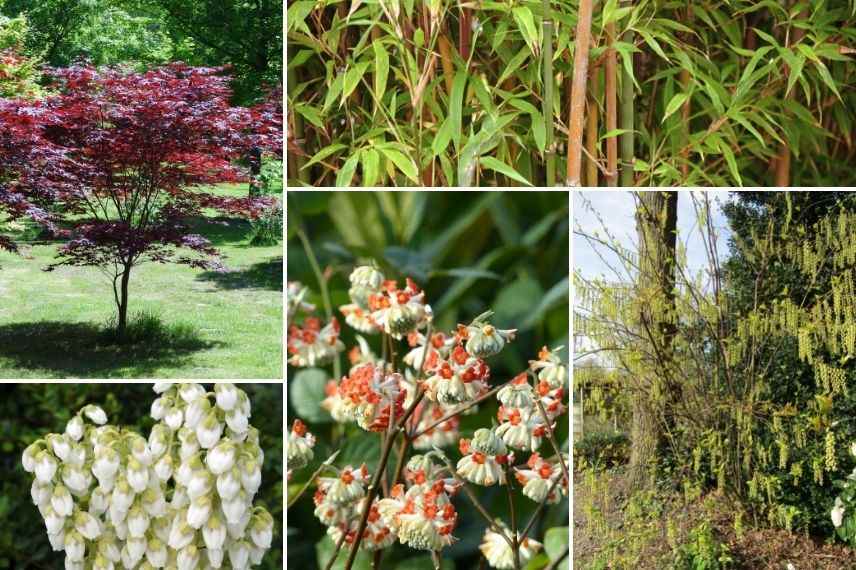
Acer palmatum ‘Atropurpureum’, bamboo, Pieris japonica ‘Debutante’, Edgeworthia chrysantha ‘Akebono Red Dragon’ and Stachyurus chinensis ‘Celina’ (photo Leonara Enking)
To create a lush and colourful atmosphere
Edgeworthia can pair beautifully with azaleas and rhododendrons to create a colourful border in partial shade. After the winter flowering of Edgeworthia, azaleas and rhododendrons can take over, offering a spectacular spring display and allowing for vibrant and cheerful arrangements in shades of white, pink, purple, red, yellow, and orange. With their often evergreen foliage, azaleas and rhododendrons create a lush atmosphere, which can be enhanced by planting beautiful ferns at the base of the border. With one or two pines at the back of the border, the exotic feel is not far away.

Edgeworthia chrysantha, Pinus strobus ‘Radiata’ (photo Wikipedia), Japanese Azalea ‘Al’s Picotee’, Adiantum pedatum Imbricatum, and Rhododendron ‘Bloombux’
Edgeworthia is a somewhat delicate plant to grow: read our complete guide to help it thrive.
To avoid any failures, we recommend planting appropriately; feel free to use our Plantfit web application!
- Subscribe!
- Contents
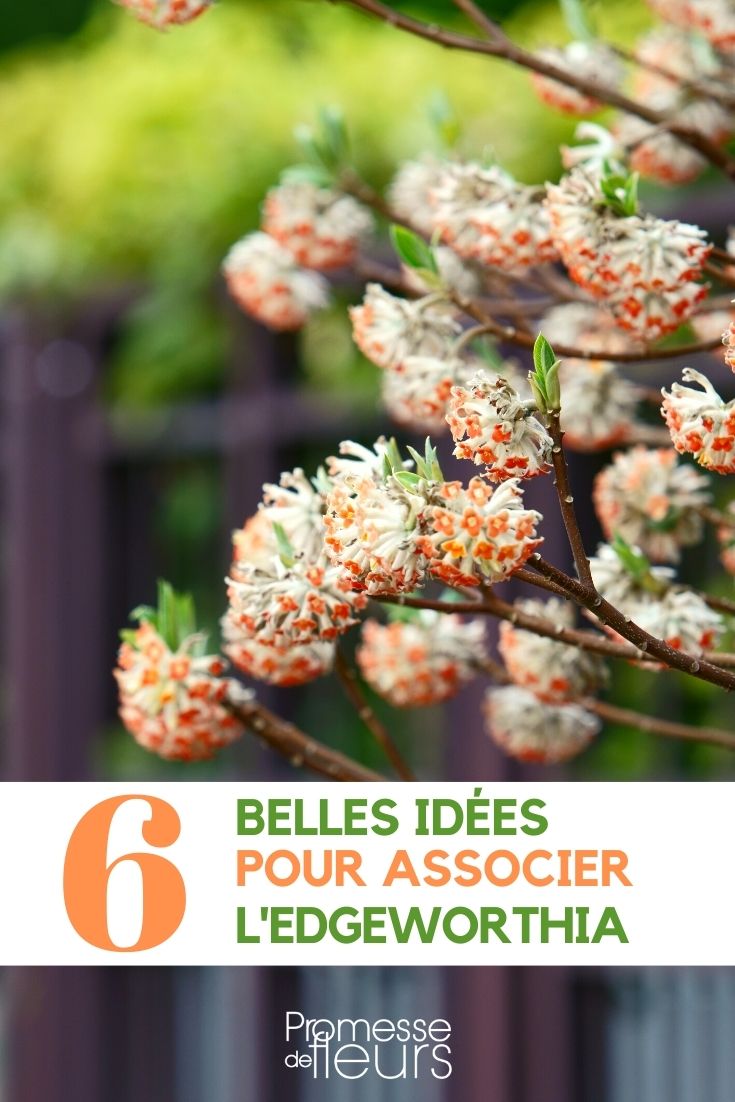































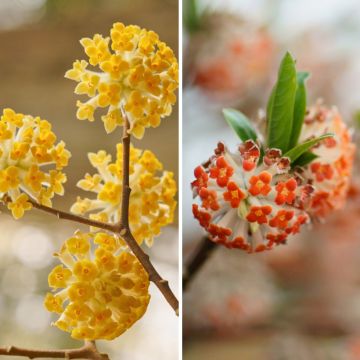
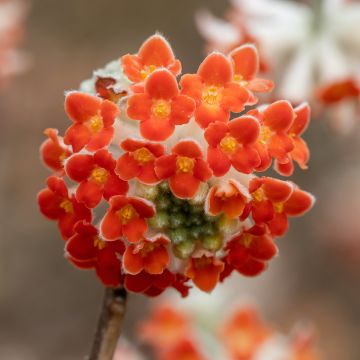
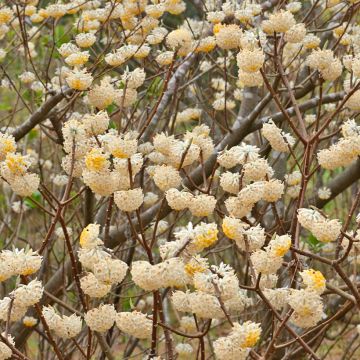
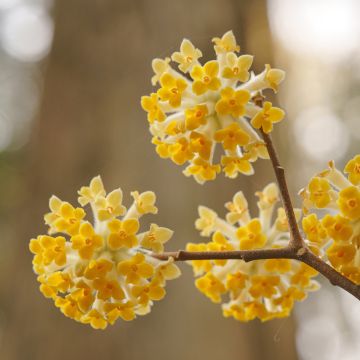
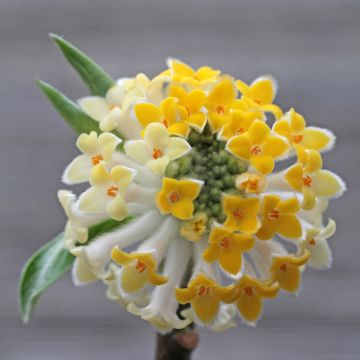

Comments